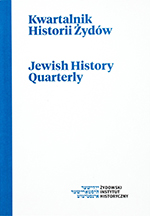Tadeusz Bornstein (1919–1942). Losy i twórczość w czasie drugiej wojny światowej
Tadeusz Bornstein (1919-1942). The Life and Artistic Output during World War II
Author(s): Magdalena TarnowskaSubject(s): Cultural history, Visual Arts, History of Judaism
Published by: Żydowski Instytut Historyczny
Keywords: Nazi occupation; Warsaw Ghetto; Jewish painting; poetry; Tadeusz Bornstein; Holocaust Art
Summary/Abstract: Tadeusz Bornstein, a talented painter and poet, came from Tomaszów Mazowiecki, from a family of affluent assimilated Jews. He studied at the Fine Arts Academy in Kraków and was about to launch his artistic career when World War II began. In the years 1939-1941 he stayed in the lands annexed by the Soviet Union, in Lvov and Białystok. He took part in exhibitions arranged by the Soviet authorities.. In June 1941 he resolved to move, together with his parents, to the Warsaw ghetto. Once there he suffered from depression, lived in isolation, painting the landscapes of the ghetto streets along with still life. He wrote poetry, in 1942 he was working on the poem “Lord Byron’s Last Face”. Nearly all his paintings got destroyed during the war, all that was left were several pieces of verse and that major poem, which were added to the collections of the Jewish Historical Institute courtesy of the actress Bogdana Majda-Minc, Bornstein’s friend from those ghetto years. We are also grateful to her for her extremely valuable information about Bornstein’s life in the ghetto, his paintings and some scarce information about his unique personality.
Journal: Kwartalnik Historii Żydów
- Issue Year: 262/2017
- Issue No: 02
- Page Range: 201-216
- Page Count: 16
- Language: Polish

